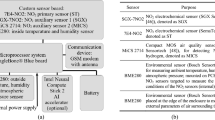Abstract
This paper presents an algorithm based on the use of artificial neural networks (ANNs) in order to reduce the processing time and to improve the accuracy in ANN modeling, which can be accomplished with a division of the model to submodels by input subintervals. We apply this method with a gas sensor aiming to accurately control the small gas leaks, thus decreasing the risk of false alarms and missed detections. The sensor model accurately, especially in small concentrations, expresses the nonlinear character of the response and the dependence on temperature and relative humidity in addition to the gas nature dependency. The corrector linearizes and compensates the sensor’s responses. The results obtained show the effectiveness of the proposed technique.








Similar content being viewed by others
References
Viharos ZJ, Kemény Z (2007) AI techniques in modelling, assignment problem solving and optimization. Eng Appl Artif Intell 20:691–698
Kim JY, Kang SW, Shin TZ, Yang MK, Lee KS (2006) Design of a smart gas sensor system for room air-cleaner of automobile-thick-film metal oxide semiconductor gas sensor. IEEE Strateg Technol 20:72–75
Gaura E, Newman RM (2004) Smart. Intelligent and cogent microsensors intelligence for sensors and sensors for intelligence, NSTI Nanotechnol
Zhuiykov S (2008) Gas sensor applications of oxygen-ionic electrolytes development of their electron mode. Sens Actuators B Chem 130(1):488–496
Andrei P, Fields LL, Zheng JP, Cheng Y, Xiong P (2007) Modeling and simulation of single nanobelt SnO2 gas sensors with FET structure. Sens Actuators B Chem 128(1):226–234
Fort A, Rocchi S, Santos S, Spinicci R, Vignoli V (2004) Electronic noses based on metal oxide gas sensors the problem of selectivity enhancement. In: Proceedings of the 21st IEEE, instrumentation and measurement, vol 1, pp 599–604
Bendahan M, Guérin J, Boulmani R, Aguir K (2007) WO3 sensor response according to operating temperature: experiment and modeling. Sens Actuators B Chem 124(1):24–29
Iglesias GE, Iglesias EA (1988) Linearization of transducer signals using an analog-to-digital converter. IEEE Trans Instrum Meas 37:53–57
Vargha B, Zoltán I (2001) Calibration algorithm for current-output R-2R ladders. IEEE Trans Instrum Meas 50:1216–1220
Renneberg C, Lehmann T (2007) Analog circuits for thermistor linearization with Chebyshev-optimal linearity error. (ECCTD07), August 26–30. Sevilla, Spain
Cristaldi L, Ferro A, Lazzaroni M, Ottoboni R (2001) A linearization method for commercial Hall-effect current transducer. IEEE Trans Instrum Meas 50(5):1149–1153
James HT, Antoniotti AJ (1993) Linearisation algorithms for computer-aided control engineering. IEEE Contr Syst Magaz 13(2):58–64
Patranbis D, Gosh D (1989) A novel software based transducer linearizer. IEEE Trans Instrum Meas 38(6):1122–1126
Malcovati P, Leme CA, O’Leary P, Maloberti F, Baltes H (1994) Smart sensor interface with A/D conversion and programmable calibration. IEEE J Solid-State Circuits 29:963–966
Baha H, Dibi Z (2009) Aspects of gas sensor’s modeling and implementation in a dynamic environment. Sens Trasducer J 109(10):1–12
Baha H, Dibi Z (2009) A novel neural network-based technique for smart gas sensors operating in a dynamic environment. Sensors 9:8944–8960
Viharos ZJ, Monostori L, Novák K, Tóth G, Csongrádi Z, Kenderesy T, Sólymosi T, Lőrincz A, Kóródi T (2003) Monitoring of complex production systems in view of digital factorie. In: Proceedings of the 17th IMEKO World Congress Metrology in the 3rd Millennium. pp 1463–1468
Viharos ZJ (2005) Automatic generation of a net of models for high and low levels of production. In: Proceedings of the 16th IFAC World Congress, Reg. No. 05127
Figaro Gas Sensor Company (2000) Technical information on usage of TGS sensors for toxic and explosive gas leak detectors: Figaro Gas Sensor Company: Osaka, Japan
Author information
Authors and Affiliations
Corresponding author
Rights and permissions
About this article
Cite this article
Hakim, B., Zohir, D. Enhancement of the neural network modeling accuracy using a submodeling decomposition-based technique, application in gas sensor. Neural Comput & Applic 21, 1981–1986 (2012). https://doi.org/10.1007/s00521-011-0601-y
Received:
Accepted:
Published:
Issue Date:
DOI: https://doi.org/10.1007/s00521-011-0601-y




